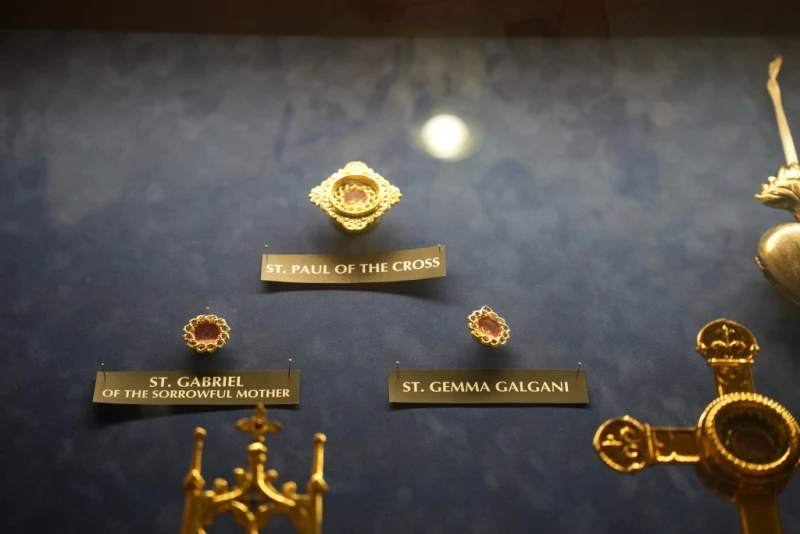

The relic of St. Gemma Galgani rests in the reliquary at the Newman Center at the University of Nebraska-Lincoln, Wednesday, Oct. 8, 2025. / Credit: Corbin Hubbell
CNA Staff, Oct 10, 2025 / 15:07 pm (CNA).
The Diocese of Lincoln, Nebraska, has determined that a moving relic was “not of supernatural origin” after video of the apparent phenomenon spread across social media.
The viral video depicted a first-class relic of St. Gemma Galgani appearing to move of its own accord behind a display case.
A relic of St. Gemma Galgani has reportedly moved within its sealed reliquary at the University of Nebraska–Lincoln’s Newman Center, drawing Catholics from across the state eager to witness it.
Video: Lillian Johnson pic.twitter.com/DngPROJScQ
— Sachin Jose (@Sachinettiyil) October 8, 2025
Visitors reportedly came to the Newman Center at the University of Nebraska-Lincoln to see the apparently moving relic.
But a diocesan investigation found that the source of the movement was a bent hook.
Father Caleb La Rue, the chancellor for the Diocese of Lincoln, investigated whether the moving relic could be of supernatural origin with the help of another priest.
He told CNA that the Church has to look at such things with a “healthy skepticism” to see if there are any “natural” causes of the occurrences.
“Not that these things can’t happen — of course, they absolutely can,” he said. “God can work in any myriad of ways.”
La Rue found that the hook was bent, causing a similar relic to move in the same way when hung on the same hook. When St. Gemma’s relic was removed from the hook, it ceased moving on its own. La Rue said because of the bend in the hook, the weight of the reliquary was likely “not evenly distributed.”

But La Rue also noted that miracles do happen and encouraged people to look for the ordinary ways God shows his presence in our lives.
“Even if it’s not supernatural, I think there’s something that God wants all of us to take away from this experience because he either willed or permitted it to happen,” La Rue said.
What qualifies as a miracle?
Church authorities investigate alleged miracles when they receive reports of them. Apparently miraculous phenomena often have to do with the Eucharist, Marian apparitions, and miracles of healing, among others.
Michael O’Neill, a miracle expert who developed a miracle-tracking website and hosts the EWTN show “Miracle Hunter,” told CNA that the Church “would not in modern times investigate a moving relic.”
“Traditionally, only a few types of miracles are ever investigated, specifically healing miracles, Marian apparitions, Eucharistic miracles, weeping statues or icons, and incorrupt saints,” O’Neill said. “And each has their own investigative process.”
La Rue, however, noted that it’s not impossible for a relic to be moving miraculously in this way.
“It’s, of course, possible. There’s far more miraculous things that happen every day,” La Rue said. “You don’t want to prematurely begin dampening the fervor. But at the same time, the Church is cautious for a reason because she wants our attention to be on truly miraculous things.”
Do miracles still occur?
The Church has documented many miracles related to healing, the Eucharist, and Marian apparitions.
Healing miracles are especially important in the investigation of potential saints. Would-be-saints need several miraculous healings to be attributed to their intercession before the Church will canonize them.
These healing miracles undergo a scrutinous investigation in line with what is called “the Lambertini Criteria,” according to O’Neill. A miracle can be confirmed only if there is no possible scientific explanation for the healing.
The Diocese of Lincoln noted in a statement that miracles still do occur, especially the miracle of the Eucharist, where the consecrated bread and wine become Jesus’ body, blood, soul, and divinity.
“God surrounds us with miracles every day, with the Lord’s real presence in the Blessed Sacrament being preeminent of all,” the diocese said in a statement shared with CNA on Thursday.
La Rue noted that the Newman Center has all-day Eucharistic adoration, where students and staff come to pray in the presence of Jesus Christ.
“The entire time this was happening, there was Eucharistic exposition going on,” La Rue said.
He noted that the Eucharist “is the ultimate sign of God’s abiding presence with his people and his desire to be a part of our life.”
“Even if this wasn’t what some people were hoping it would be, it doesn’t mean that God isn’t still very active in our lives,” La Rue said. “Sometimes we maybe just don’t pay attention to the little ways in which he is.”
O’Neill noted that the official norms for addressing miracles were adjusted last year, meaning that the Church doesn’t explicitly declare occurrences to be supernatural, but rather uses the designation “nihil obstat,” meaning “nothing obstructs.”
This means that the miracle has “signs” of the Holy Spirit and nothing “critical or risky” has been detected.
While nihil obstat is the highest designation a proposed miracle can receive in modern times, the Vatican, according to the recent norms, can also denounce alleged miracles if the Church finds them to be concerning, not of supernatural origin, or even fraudulent.
La Rue encouraged those who had hoped for a miracle to “be mindful of the ordinary ways in which God communicates his love and his grace to us throughout the day.”
“It doesn’t necessarily need to be something spectacular, but there’s lots of little ways that God is constantly showing us his care for us,” La Rue said.
A thriving faith community
La Rue, who is in residence at the Newman Center, noted that the vibrant community is growing.
“It’s a place where young people are really encountering Our Lord and encountering each other and building strong friendships and lasting friendships founded on shared love of God and wanting to live a full life, a joyful life,” La Rue said.
About 70 people entered the Church through the center’s OCIA program last year.
“The number of people who came to join the church last year who just literally just showed up — nobody went and found them,” La Rue said. “We certainly have those people, but a lot of them just came on their own.”
Sunday Mass, he said, is “standing room only.”
“I’ve been able to see just the reality of young people recognizing that the world doesn’t have the answers — that the things of the world aren’t satisfying,” he said. “And they come here to find actual peace and love and freedom in Our Lord.”
Read More





